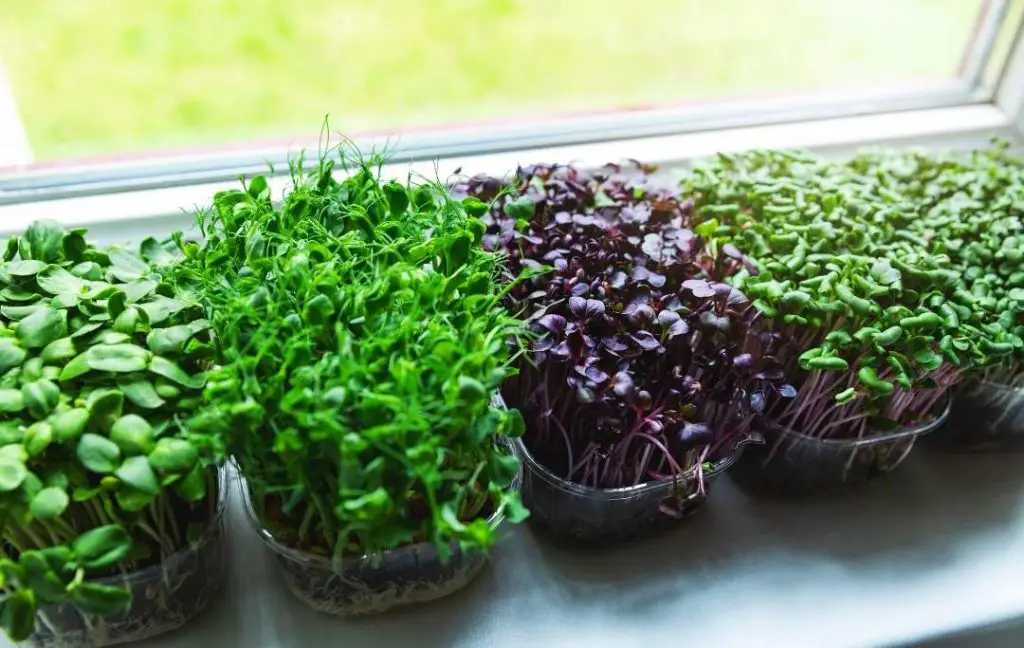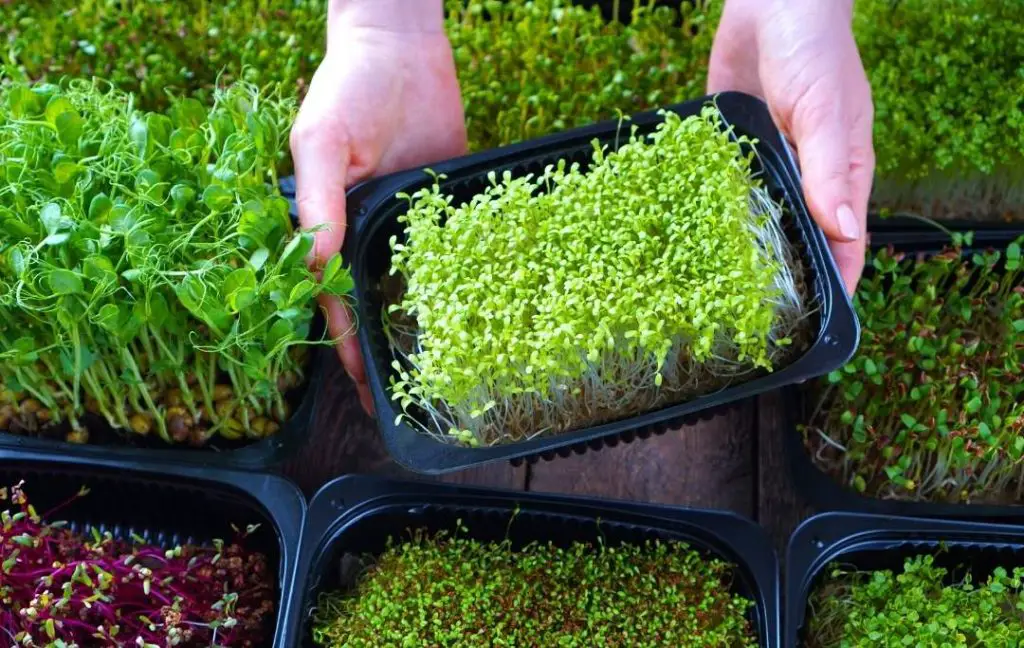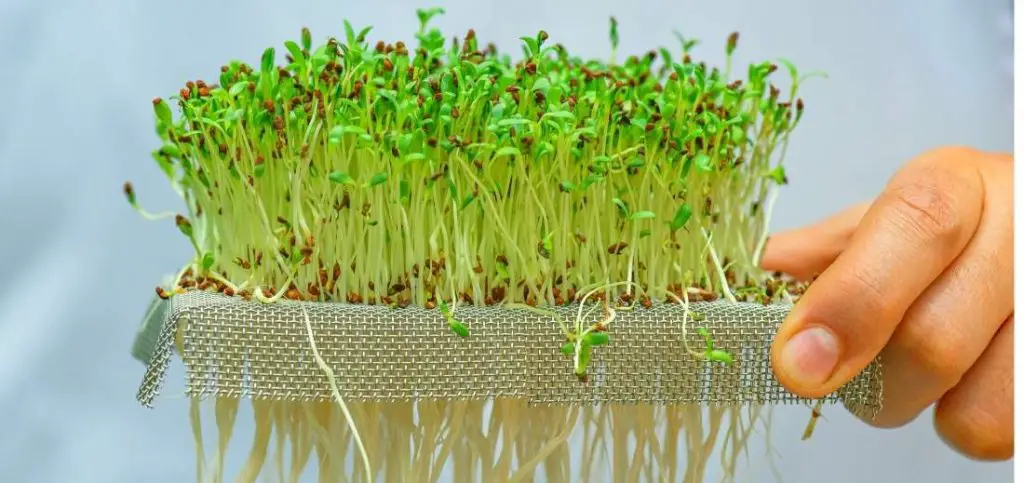It is very easy to grow microgreens at home. With a little maintenance, you are able to get these fast-growing crunchy flavor crops. As an indoor gardener, you must have limited space that’s why you want to do indoor gardening. You can grow them anywhere at your home because these are not occupying too much space.
Microgreens are that type of plants that can be harvested when they are too young. This specialty makes them different from other plants. There are two ways to grow microgreens, you can grow them either in soil or without soil. In each method, you need different materials except seeds.

We will check the materials of both methods one by one. First, we will discuss the method by which soil is used.
Buy Microgreens Growing Kits On Amazon
Read More: How To Grow Your Salad Greens Without A Garden?
Materials Used In Soil Method

The things you need in this method are as follows
- Seeds
- Water
- Container / Pot which is at least 2 inches deep.
- Spray Bottle / Water Can / Hose Spray
- Potting Soil / Compost or Hydroponic Soil Mix
- Grows light or Windowsill with Light
Buy Microgreens Growing Kits On Amazon
Seeds
If you want to speed up the germination process of plants, soak up your seeds before planting. You should check the instructions about soaking. The specific process of soaking needs a few hours to overnight. If there is no instruction mentioned on the packet about the shocking, it is safer not to soak your seeds. Larger seeds need soil, you can’t grow them without soil. Smaller seeds like lettuce or kale are easy to grow with or without soil.
Which seeds work best
The different varieties of microgreens are salad greens, leafy vegetables, herbs, and nutritive edible flowers. Beginners usually start growing by using one type of seed such as broccoli, cauliflower, cabbage, mustard, chia, sunflower, or buckwheat. These types are very easy to grow varieties of microgreens. You can sow different varieties of seeds in several containers so you can get different types of microgreens after harvesting.
Where you find the seeds for growing microgreens
The prices of the seeds are very low as you can select any seed company and check their catalogs to find a vegetable selection for the best microgreens to grow. You must select organic seeds rather than conventionally grown seeds. It is good for you and your family’s health. Seed suppliers are so cell seed mixtures.
The best microgreens to grow
The best microgreens which you grow at your home are Arugula, Basil, Broccoli, Buckwheat, Cabbage, Chives, Cilantro, Cress, Onion, Orach, Spinach, Sorrel, Kale, Lemongrass, and Parsley.
Try these (greens which are mentioned above) colorful and fast-growing microgreens in this winter. You can have an endless production of healthy green this season.
Water
At the start, lightly water the microgreens. After two days, when seedlings become established you can use a spray bottle so your soil cannot dry out. Some plants need frequent water like lettuce which fruits are more deeply rooted. Microgreens are shallow-rooted plants so they need frequent watering. Be moderate in watering and avoid overwatering. overwatering can destroy your seeds’ root and they fail to grow.
Read More: Growing Microgreens Indoors Without Soil
Lighting Requirement
The starting period of about three to five days, after sowing, you have to maintain humidity, not light. But after sprouting the seeds your plants need at least three to four hours of sunlight. The quantity of light depends on the variety of microgreens some plants need more light and some less.
It is important to know that we are growing only the first set of true leaves and then harvest them. If your plants are not getting sunlight according to their requirement you can see the burn spots on the leaves. At this stage, you can use artificial light to prevent your plants from withering. You should place the light at least 4 inches above the top of the leaves.
Potting Soil
If you want the best soil for your microgreens then it should be made of 80% organic material like peat moss and compost. The ingredients of the growing medium are very important because your plants get nutrients from it. These ingredients provide your plant’s moisture, oxygen, and suitable nutrients which are necessary for the solid structure of plants.
Buy Microgreens Growing Kits On Amazon
Materials Need in Soilless Method

Now we will start discussing all the materials which we need in growing microgreens but without soil.
- Seeds
- Water
- Growing Medium
- Growing Trays
- pH Testing Kit
- Light
Water
You should use clean, filtered, or boiled water because you are not using the soil. The water is now the major source to provide all the basic nutrients to your microgreens. If it is needed you can add liquid fertilizer to water and then use it. It is important to know that the pH of the water should be six then microgreens grow better.
Growing Medium
You can use a different growing medium and you have many options. But you should use coconut coir or hemp growing mat. These are really good, especially for growing microgreens.
Read More: How to Grow Microgreen indoors?
Growing Trays
In this method, you need a tray which should be around 20 × 10 inches. The depth of the tray should be 1.5 inches to 2 inches. In the hydroponic method, we don’t need holes in our tray.
pH Testing Kit
As you are using water instead of soil to grow your microgreens. It is necessary to check the pH of water for this purpose we use a pH testing kit. The pH of the water should be 6. After checking the pH you can easily justify the pH of water according to your needs.
Light
At the start, we cover our tray with another tray but after 4 to 5 days we need light to start the photosynthesis process for the growth of our plants. If it is not possible for you to provide at least three to four hours of sunlight for your plants. You can use good LED grow lights for this purpose. In your balcony or window sill, there is no need to get an LED to grow light.
